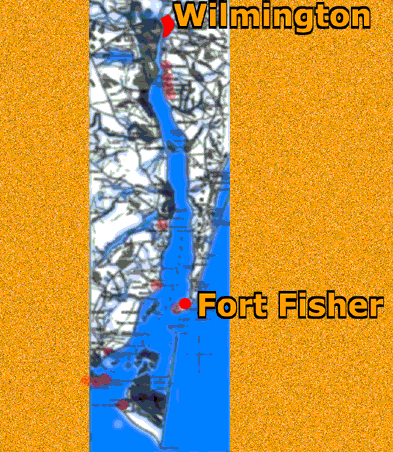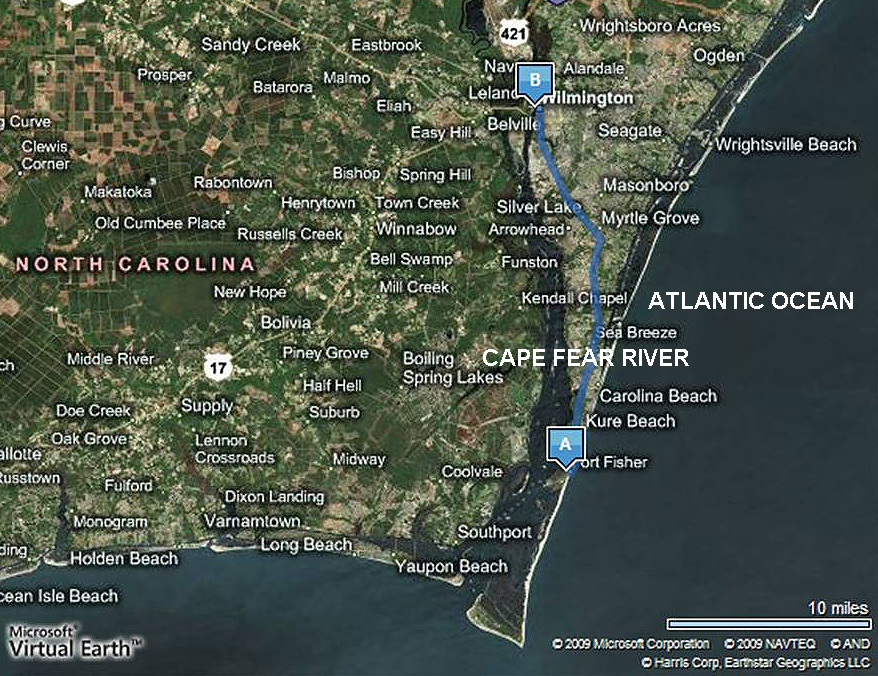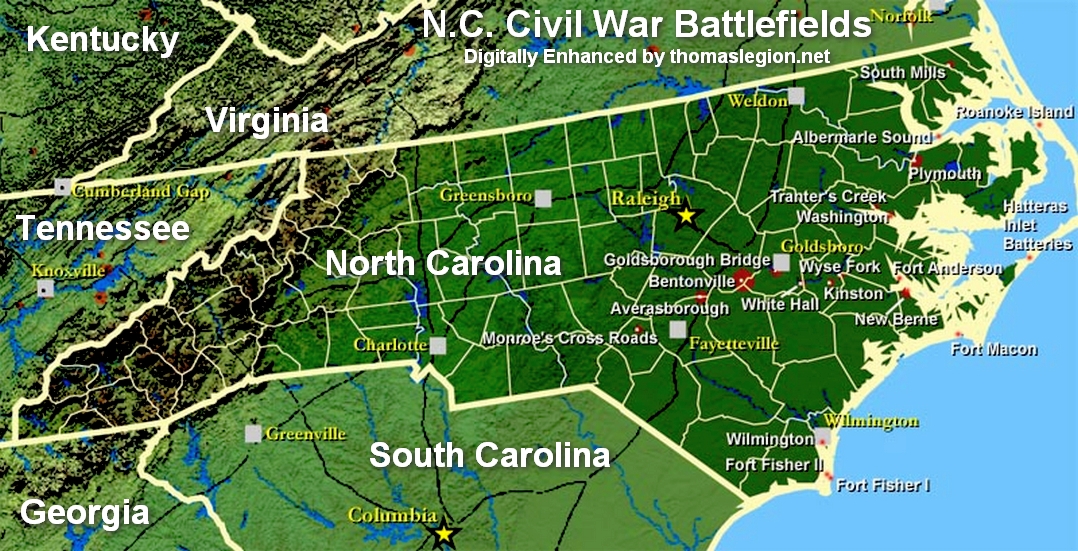|
Wilmington, North Carolina
American Civil War History
Wilmington, North Carolina, and the Civil War
| Wilmington during the Civil War |

|
| WIlmington was defended by the Cape Fear Defenses |
During the American Civil War (1861-1865), Wilmington
was the largest city in North Caroline and a major Atlantic Ocean port for the Confederate States. A vital lifeline
for the fledgling Confederacy to trading partners in Europe, Wilmington was one of the
last ports to fall to the Union Army. In defense of the port city and with only limited resources, Gen. Robert E. Lee
and other strategists mulled over the Tar Heel State's coastal defenses, such as the Cape Fear River Defense System.
(Right) Fort Fisher and
the Cape Fear Defenses guarding Wilmington.
Wilmington was located 30 miles upstream (north) from
the mouth of the Cape Fear River (which flows into the Atlantic Ocean) and was among
the Confederacy’s most important cities. It ranked 13th in size in the CSA (although only 100th in the pre-war
United States) with a population of 9,553 according to the 1860 census, making it virtually the same size as Atlanta, Georgia,
at the time.
| Fort Fisher (A) to Wilmington (B) Route Map |

|
| Fort Fisher (A) to Wilmington (B) Route Map. Two strategic locations during the Civil War. |
Wilmington
was therefore a vital point of entry for supplies bound for the Southern states.
Its port traded cotton and tobacco in exchange for foreign goods, such as munitions, clothing and foodstuffs. These shipments
were transferred to railroad cars, namely the Wilmington and Weldon Railroad, and sent from the city throughout the South. This nourished both the Southern states in general and specifically
General Robert E. Lee's forces in Virginia.
In its entirety, the trade was based on the departing and arriving steamer ships of British smugglers. These vessels were
referred to as blockade-runners because they had to avoid and run through the Union blockade, which traversed along
the entire Southern coastline. See also The Blockade of Wilmington, North Carolina.
Mostly, these blockade-runners
stemmed indirectly from British colonies–such as Bermuda, the Bahamas,
or Nova Scotia. Often, they were forced to fly the Confederacy's
insignia explicitly because Abraham Lincoln had imposed the death penalty on British "pirates" captured in the region. Along
with vital supplies, the blockade-runners brought foreign crews, which poured money into the local economy through bars, taverns,
hotels, shops, and merchants. The town soon took on an international flavor not seen before the war.
Unfortunately, in the summer
of 1862, one of these blockade-runners also brought in sailors who were infected with yellow fever, which soon paralyzed the
once-thriving waterfront, as well as much of the city itself. Nearly 1,000 people were ultimately infected with the disease,
and over 300 of them died before the illness had run its course.
After the fall of Norfolk,
Virginia, in May 1862, Wilmington’s
importance was further increased. It became the main Confederate port on the Atlantic Ocean.
Along the Atlantic seashore, Wilmington's defenses were so sturdy that they were only surpassed
by Charleston's fortifications in South Carolina.
Wilmington resisted Federal occupation for a protracted period, mainly due to the presence
of the Cape Fear River Defense
System, which included the formidable Fort Fisher.
| Wilmington during the Civil War |

|
| Wilmington Civil War Battle |
Blockade-running
would become an organized industry. The Crenshaw Company organized shipments of cotton from the interior of the Confederacy
to Wilmington.
Then, the shipments were smuggled through the blockade and to England.
Wilmington
was not captured by Union forces until February 22, 1865, during the Operations against Fort Fisher and Wilmington, and approximately one month after the successful victory at the Second Battle of Fort Fisher. The Battle of Wilmington consisted of a series of three small engagements near the Cape Fear River that led
to the abandonment of the city by the Confederate forces under General Braxton Bragg. Before evacuating, Bragg ordered large
quantities of bales of cotton and tobacco burned so that they would not fall into Union hands. Maj. Gen. Jacob D. Cox soon
thereafter led the first Federal troops into Wilmington, which
would remain in Union control for the remainder of the war.
Since almost all the military
action was some distance from the city itself, a number of antebellum homes and other buildings are still extant in downtown
Wilmington.
References: Yearns, W. Buck and Barret, John G., eds., North Carolina
Civil War Documentary, 1980; Official Records of the Union and Confederate Armies
Recommended
Reading: The Wilmington Campaign: Last Departing Rays of Hope.
Description: While prior books on the battle to capture Wilmington,
North Carolina, have focused solely on the epic struggles for Fort Fisher, in many respects this was just
the beginning of the campaign. In addition to complete coverage (with significant new information) of both battles for Fort Fisher, "The Wilmington Campaign" includes the first
detailed examination of the attack and defense of Fort Anderson. It also features blow-by-blow accounts of the defense of the Sugar Loaf Line
and of the operations of Federal warships on the Cape Fear River. Continued below…
This masterpiece
of military history proves yet again that there is still much to be learned about the American Civil War. "The Wilmington Campaign is a splendid achievement. This gripping chronicle of the five-weeks'
campaign up the Cape
Fear River adds a crucial dimension to our understanding of the Confederacy's collapse." -James McPherson, Pulitzer
Prize-winning author of Battle Cry of Freedom
Recommended
Reading: The Wilmington Campaign and the Battle for Fort Fisher, by Mark A. Moore. Description:
Full campaign and battle history of the largest combined operation in U.S.
military history prior to World War II. By late 1864, Wilmington
was the last major Confederate blockade-running seaport open to the outside world. The final battle for the port city's protector--Fort Fisher--culminated
in the largest naval bombardment of the American Civil War, and one of the worst hand-to-hand engagements in four years of
bloody fighting. Continued below…
Copious illustrations,
including 54 original maps drawn by the author. Fresh new analysis on the fall of Fort Fisher, with a fascinating comparison
to Russian defenses at Sebastopol during the Crimean War. “A tour de force. Moore's Fort Fisher-Wilmington Campaign is the best publication of this
character that I have seen in more than 50 years.” -- Edwin C. Bearss, Chief Historian Emeritus, National Park Service
Recommended
Reading: Confederate Goliath: The Battle of
Fort Fisher. From Publishers Weekly: Late in the Civil War, Wilmington,
N.C., was the sole remaining seaport supplying Lee's army at Petersburg, Va., with rations and munitions. In this dramatic
account, Gragg describes the two-phase campaign by which Union forces captured the fort that guarded Wilmington and the subsequent
occupation of the city itself--a victory that virtually doomed the Confederacy. In the initial phase in December 1864, General
Ben Butler and Admiral David Porter directed an unsuccessful amphibious assault against Fort Fisher that included the war's heaviest
artillery bombardment. Continued below…
The second
try in January '65 brought General Alfred Terry's 9000-man army against 1500 ill-equipped defenders, climaxing in a bloody
hand-to-hand struggle inside the bastion and an overwhelming Union victory. Although historians tend to downplay the event,
it was nevertheless as strategically decisive as the earlier fall of either Vicksburg or Atlanta. Gragg
has done a fine job in restoring this important campaign to public attention. Includes numerous photos.
Recommended
Reading: Fort Anderson: The Battle For Wilmington. Description: A detailed but highly readable study of the largest
and strongest interior fortification guarding the Confederacy's last major seaport of Wilmington,
North Carolina. An imposing earthen bastion, Fort Anderson was the scene of a massive two-day
Union naval bombardment and ground assault in late February 1865. Continued below…
The fort's
fall sealed Wilmington's doom. More than a military campaign study, Fort
Anderson: Battle for Wilmington
examines the history of the fort's location from its halcyon days as North Carolina's leading
colonial port of Brunswick
to its beginnings as a Confederate fortification in 1862 and its fall to Union forces three years later. The fort also had
several eerie connections to President Abraham Lincoln's assassination. Today the fort is part of the tranquil Brunswick Town
State Historic Site. Fort Anderson: Battle for Wilmington is liberally illustrated
with maps and illustrations, including many previously unpublished soldiers' images. It also contains an order of battle,
endnotes, bibliography and index.
Recommended Reading: Ironclads and Columbiads: The Coast (The Civil War in North Carolina)
(456 pages). Description: Ironclads and Columbiads
covers some of the most important battles and campaigns in the state. In January 1862, Union forces began in earnest to occupy
crucial points on the North Carolina coast. Within six months,
Union army and naval forces effectively controlled coastal North Carolina from the Virginia line south to present-day Morehead
City. Union setbacks in Virginia, however, led to the withdrawal of many
federal soldiers from North Carolina, leaving only enough Union troops to hold a few coastal strongholds—the vital ports
and railroad junctions. The South during the Civil War, moreover, hotly contested the North’s ability to maintain its
grip on these key coastal strongholds.
Recommended Reading: Lifeline
of the Confederacy: Blockade Running During the Civil War (Studies in Maritime History Series). From
Library Journal: From the profusion of books about Confederate blockade running, this one will stand out for a long time as
the most complete and exhaustively researched. …Wise sets out to provide a detailed study, giving particular attention
to the blockade runners' effects on the Confederate war effort. It was, he finds, tapping hitherto unused sources, absolutely
essential, affording the South a virtual lifeline of military necessities until the war's last days. This book covers it all:
from cargoes to ship outfitting, from individuals and companies to financing at both ends. An indispensable addition to Civil
War literature.
|

